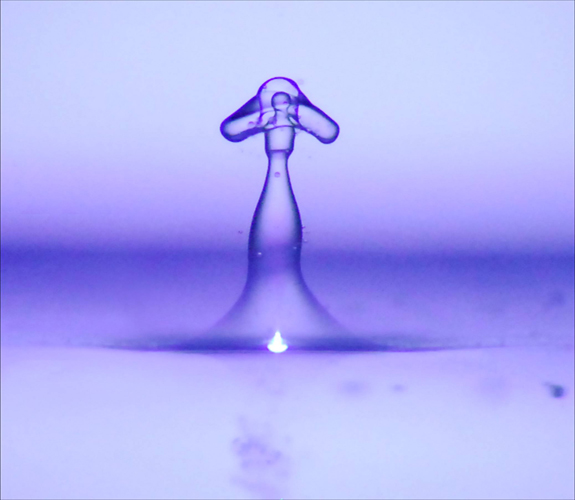Interfacial Jets: An Oscillating Bubble Collapses Near a Fluid-Fluid Interface
Silvestre Roberto Gonzalez Avila, Soon Yew Lim,
Nanyang Technological University, Singapore
Jedd Betari,
École Polytechnique, France
Siew-Wan Ohl, Evert Klaseboer,
Institute of High Performance Computing, Singapore
Boo Cheong Khoo
Department of Mechanical Engineering,
National University of Singapore

A fluid-fluid interface between two immiscible liquids of different densities is formed, here on top water and below a denser liquid (hydrofluoroether, also known as HFE). HFE is 1.5 times denser than water yet both liquids have very similar viscosity. An explosively expanding bubble with a maximum bubble radius of 0.68 mm is generated by vaporizing the water just above the fluid-fluid interface with a short laser pulse. The first growth-shrink cycle of the bubble lasts only 40 microseconds. During the shrinkage or so-called collapse of the bubble, a jet is formed and accelerated from the top of the bubble towards the heavier liquid HFE. This phenomenon is analogous to that of an oscillating bubble collapsing near rigid boundaries, where jetting is always observed towards the surface. Interestingly the liquid-liquid interface with a density ratio of 1.5 acts very similar and induces the bubble to collapse with a jet towards it.
After the collapse of the bubble, the remnants of the bubble (pockets of gas) are injected into HFE liquid. Seemingly in response, the HFE develops a jet that shoots back into the water above it. As the result of surface instabilities the jet develops a 'crown' like structure on its top. Eventually the top 'crown' part of the jet breaks off into a separate droplet which later returns back into the HFE due to gravity. Thus in the end, the initial clean fluid-fluid interface is restored.
This work is funded by the Ministry of Education Singapore (T208A1238), and Ecole Polytechnique, France
References
1. Lord Rayleigh 1917, Philos. Mag. 34, 94-98.
2. Lauteborn W. & Bolle H. 1975, J. Fluid. Mech. 72, 391-399.
3. Klaseboer E., Khoo B.C. & Hung K.C. 2005, J. Fluids Struct. 21, 395-412.
4. Robinson P.B., Blake J.R., Kodama T., Shima A. & Tomita Y. 2001, J. Appl. Phys. 89, 8225-8237.
5. Chahine G.L. 1977, J. Fluids Engng., Trans. ASME 99, 709-716.
6. Turangan C.K., Ong G.P., Klaseboer E. & Khoo, B.C. 2006, J. Appl. Phys. 100, 054910.
7. Klaseboer E. & Khoo, B.C. 2004, J. Appl. Phys. 96, 5808-5818.
Reporters and Editors
Reporters may freely use this image. Credit: Cavitation Lab, School of Physical and Mathematical Sciences (SPMS), Nanyang Technological University.
